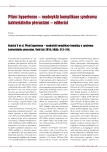Changes in lipoprotein spectrum in patients with the diagnosis of extremito-vascular ischemic disease
Authors:
S. Oravec; A. Dukát; P. Gavornik; M. Čaprnda; O. Reinoldová
Authors‘ workplace:
II. interná klinika Lekárskej fakulty UK Bratislava, Slovenská republika, prednosta prof. MU Dr. Andrej Dukát, CSc., FESC
Published in:
Vnitř Lék 2010; 56(6): 620-623
Category:
65th Birthday - Petr Svacina, MD
Overview
New method of lipoprotein determination on polyacrylamid gel with Lipoprint LDL system quantifies non atherogenic and atherogenic plasma lipoproteins, including small dense LDL, the potent atherogenic lipoprotein subpopulations. According to majority of non atherogenic versus atherogenic lipoprotein in the whole lipoprotein spectrum, this method distinguishes a non atherogenic lipoprotein profile phenotype A from an atherogenic lipoprotein profile phenotype B. Definitely, the contribution of this method is focusing on the atherogenic lipoprotein profile phenotype B in 80% of patients with an extremito‑ vascular ischemic disease and on the existence of control subgroup of normolipemic subjects with an atherogenic lipoprotein profile (7% of probands of control group). These persons represent a risk population. Till now, the facilities for identifying of these “normolipemic persons at risk” are limited.
Key words:
atherogenic lipoproteins – atherogenic vs non atherogenic lipoprotein profile
Sources
1. Superko HR. Lipoprotein subclasses and atherosclerosis. Front Biosci 2001; 6: D355– D365.
2. Berneis KK, Krauss RM. Metabolic origins and clinical significance of LDL heterogeneity. J Lipid Res 2002; 43: 1363– 1379.
3. Packard CJ. Triacylglycerol‑ rich lipoproteins and the generation of small dense low‑ density lipoprotein. Biochem Soc Trans 2003; 31: 1066– 1069.
4. Shoji T, Hatsuda S, Tsuchikura S et al. Small dense low‑ density lipoprotein cholesterol concentration and carotid atherosclerosis. Atherosclerosis 2009; 202: 582– 588.
5. Austin MA, King MC, Vranizan KM et al. Atherogenic lipoprotein phenotype. A proposed genetic marker for coronary heart disease risk. Circulation 1990; 82: 495– 506.
6. Van J, Pan J, Charles MA et al. Atherogenic lipid phenotype in a general group of subjects. Arch Pathol Lab Med 2007; 131: 1679– 1685.
7. Hoefner DM, Hodel SD, O’Brien JF et al. Development of a rapid quantitative method for LDL subfraction with use of the Quantimetrix Lipoprint LDL system. Clin Chem 2001; 47: 266– 274.
8. Oravec S. Nová laboratórno‑ medicínska pomoc v diagnostike dyslipoproteínemií a kardiovaskulárnych ochorení: Identifikácia LDL podskupín. Med Milit Slov 2006; 8: 28– 32.
9. Oravec S. Identifikácia subpopulácií LDL triedy – Aktuálny prínos v diagnostike porúch metabolizmu lipoproteínov a ochorení kardiovaskulárneho systému. Med Milit Slov 2006; 8: 32– 34.
10. Oravec S. Nové perspektívy v diagnostike porúch metabolizmu lipoproteínov – prínos v interpretácii výsledkov. Med Milit Slov 2007; 9: 42– 45.
11. Gavorník P. Etiopatogenéza a nová klinicko‑etiologicko‑anatomicko‑patologická (CEAP) klasifikácia končatinovej choroby. Interní Med 2010; 10: 115– 123.
12. Gavorník P. Všeobecná angiológia. Angiologická propedeutika. Cievne choroby. Bratislava: Vydavateľstvo Univerzity Komenského 2001.
13. Hirsch AT, Haskal ZJ, Hertzer NR et al. ACC/ AHA 2005 Guidelines for the management of patients with peripheral arterial disease. J Am Coll Cardiol 2006; 47: 1239– 1312.
14. Norgren L, Hiatt WR, Dormandy JA et al. Inter‑ society consensus for the management of peripheral arterial disease. Int Angiol 2007; 26: 81– 157.
15. Vakkilainen J, Mäkimattila S, Seppälä‑ Lindroos A et al. Endothelial dysfunction in men with small LDL particles. Circulation 2000; 102: 716– 721.
Labels
Diabetology Endocrinology Internal medicineArticle was published in
Internal Medicine

2010 Issue 6
Most read in this issue
- Sepsis and the septic shock in oncological or other immunocompromised patients
-
Hyperlipoproteinemie a dyslipoproteinemie I.
Klasifikace, diagnostika, kardiovaskulární, kardiometabolické a reziduální riziko - Essential thrombocythaemia and other myeloproliferative disorders with thrombocythaemia treated with Thromboreductin. A report from the database of Register for the 1st quarter of 2010
- Different courses of recurrent or multisystem Langerhans cells histiocytosis in adults – description of 22 cases from one centre
